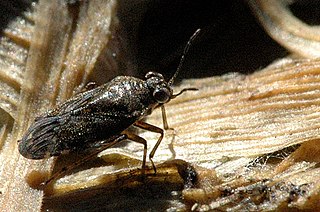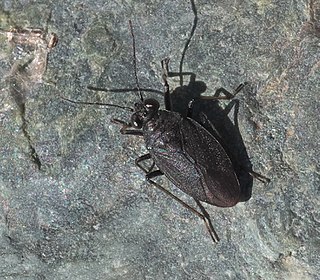
The Heteroptera are a group of about 40,000 species of insects in the order Hemiptera. They are sometimes called "true bugs", though that name more commonly refers to the Hemiptera as a whole. "Typical bugs" might be used as a more unequivocal alternative, since the heteropterans are most consistently and universally termed "bugs" among the Hemiptera. "Heteroptera" is Greek for "different wings": most species have forewings with both membranous and hardened portions ; members of the primitive sub-group Enicocephalomorpha have completely membranous wings.

Dipsocoromorpha is an infraorder of insects in the order Hemiptera containing roughly 300 species, in one superfamily, Dipsocoroidea. The insects of this group live on the ground and in the leaf litter, though they can also be found in mangroves, low vegetation areas, and interstitial areas of streams.

Nepomorpha is an infraorder of insects in the "true bug" order (Hemiptera). They belong to the "typical" bugs of the suborder Heteroptera. Due to their aquatic habits, these animals are known as true water bugs. They occur all over the world outside the polar regions, with about 2,000 species altogether. The Nepomorpha can be distinguished from related Heteroptera by their missing or vestigial ocelli. Also, as referred to by the obsolete name Cryptocerata, their antennae are reduced, with weak muscles, and usually carried tucked against the head.

The Ochteridae comprise a small family of insects. Eight genera with about 80 species have been described. They occur worldwide along the shore of various types of water and the greatest diversity is in tropical regions. They are "true bugs", being members of the order Hemiptera, and are in the suborder Heteroptera. Ochteridae commonly are known as the velvety shore bugs. They resemble the Saldidae shore bugs and have lengths ranging from 4.5 to 9 mm (0.18–0.35 in).

Saldidae, also known as shore bugs, are a family of insects in the order Hemiptera. They are oval-shaped and measure 2–8 mm (0.08–0.31 in) when mature. Typically they are found near shorelines or the marginal growths near freshwater bodies, estuaries, and sea coasts. They can flee by leaping or taking flight. There are about 350 recognized species with the majority from the Nearctic and Palearctic. Many species are found in the intertidal zone and both adults and nymphs of some species like Saldula pallipes can tolerate submergence at high-tide. Saldidae are predators and scavengers. They pass the winter through egg or adult diapause.

Yuri Alexandrovich Popov was a Soviet and Russian paleoentomologist, an authority on the taxonomy and evolution of fossil true bugs (Heteroptera) and Coleorrhyncha. He described more than 20 new families and subfamilies and 300 new genera and species from the Mesozoic and Cenozoic. He also was one of the founders of the modern higher classification of true bugs: three of seven heteropteran infraorders have been established by him. He was the author of more than 170 publications, including a classic monograph on the evolution of water bugs.

Macrosaldula scotica is a predatory species of true bug, from the family Saldidae in the order Hemiptera from the western Palearctic.
Salda lugubris is a species of shore bug in the family Saldidae. It is found in Central America and North America.
Salda is a genus of shore bugs in the family Saldidae. There are about 18 described species in Salda.
Saldoida is a genus of shore bugs in the family Saldidae. There are about five described species in Saldoida.

Pentacora is a genus of shore bugs in the family Saldidae. There are about 12 described species in Pentacora.

Macrosaldula is a genus of shore bugs in the family Saldidae. There are more than 20 described species in Macrosaldula.

Saldula is a genus of shore bugs in the family Saldidae. There are at least 120 described species in Saldula.

Micracanthia is a genus of shore bugs in the family Saldidae. There are about 15 described species in Micracanthia.
Calacanthia is a genus of shore bugs in the family Saldidae. There are about seven described species in Calacanthia.
Chiloxanthus is a genus of shore bugs in the family Saldidae. There are about nine described species in Chiloxanthus.
Ioscytus is a genus of shore bugs in the family Saldidae. There are about seven described species in Ioscytus.
Teloleuca is a genus of shore bugs in the family Saldidae. There are about five described species in Teloleuca.
Patapius is a genus of spiny-legged bugs in the family Leptopodidae. There are about seven described species in Patapius.

Aepophilus is a monotypic genus of bugs, containing the species Aepophilus bonnairei in the monotypic subfamily Aepophilinae in the monotypic family Aepophilidae of the infraorder Leptopodomorpha. It is found on the Atlantic coast of Europe.











